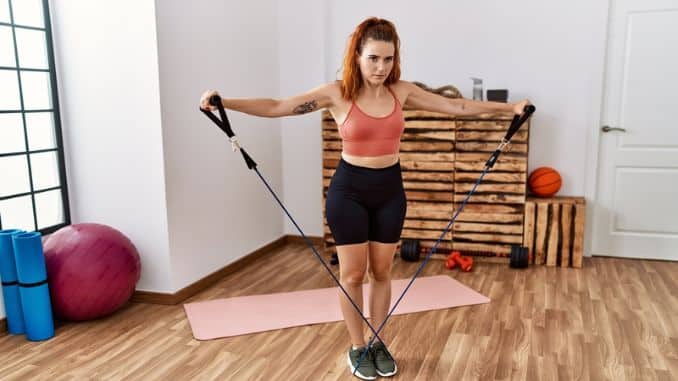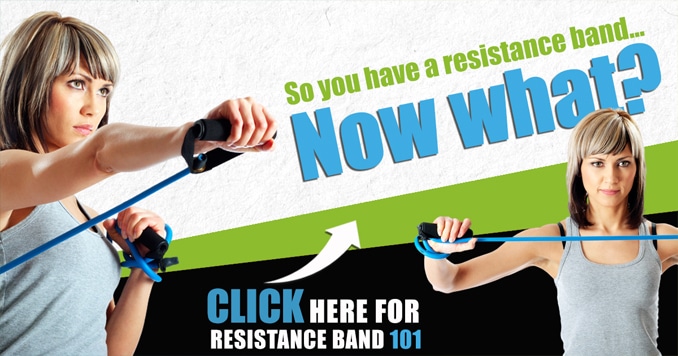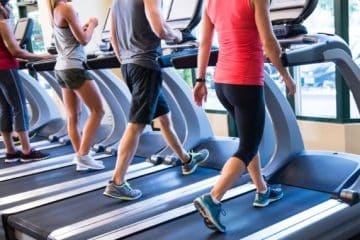Resistance band training is essential in transforming your upper body strength. It can help you achieve a more balanced and toned physique, improve posture and stability, and increase overall strength and endurance. Upper body strength is crucial for everyday activities such as lifting weights and carrying objects. It can also help prevent injuries and improve athletic performance in sports that require upper-body strength. Regularly incorporating resistance band exercises into your upper body workout routine can effectively transform your upper body and improve your overall fitness level.
What are Resistance Bands?
Resistance bands are elastic bands made of rubber or latex used for strength training exercises. They come in various shapes, sizes, and resistance levels and can target specific muscle groups, including the upper body.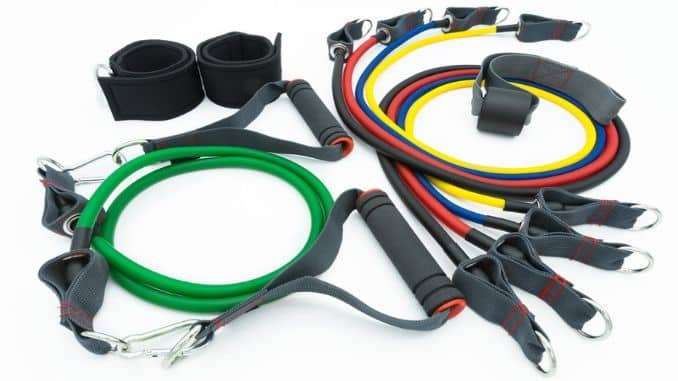
Benefits of Resistance Bands
The benefits of using resistance bands for upper body strength include:
1. Versatility
Resistance bands can perform various upper-body exercises, including chest presses, bicep curls, and triceps extensions.
2. Portability
Resistance bands are lightweight and portable, making them easy to use at home, in the gym, or while traveling.
3. Safety
Resistance bands are a low-impact form of exercise, which makes them a great option for individuals with joint pain or injuries.
4. Progressive Resistance
Resistance bands offer progressive resistance, meaning the resistance increase as the band is stretched, allowing for a more challenging workout as strength increases.
Tips for Effective Body Resistance Band Workout
A. Choose the right resistance level
It is important to choose the right resistance level for your fitness level and goals. If you are a beginner, start with a light resistance band and gradually increase the intensity as you get stronger.
B. Warm up before starting
Before you start your resistance band upper body workout, it is important to warm up your muscles to prevent injury. You can do dynamic stretches or walk on the spot for a few minutes to get your blood flowing.
C. Focus on proper form
Proper form is essential for getting the most out of your resistance band upper body workout. Ensure you maintain good posture and engage your core muscles throughout each exercise.
D. Vary your workouts
To prevent boredom and keep your muscles challenged, it is important to vary your resistance band upper body workout. You can change the angle of the band, switch up the exercises or increase the number of reps or sets.
E. Combine with other exercises
Resistance band training can be combined with other exercises such as bodyweight exercises, dumbbell workouts, or cardio exercises to create a full-body workout.
F. Stretch after your workout
After your resistance band upper body workout, it is important to stretch your muscles to prevent injury and reduce muscle soreness. You can do static stretching or use a foam roller to massage your muscles.
G. Checking for Rips and Tears
It is essential to check for any signs of damage, including rips and tears by doing a visual inspection and carefully examining the entire band length, looking for any visible tears, fraying, or weak stops. Inspecting your resistance bands before each use is a good practice to ensure your safety and optimize your workout experience.
By following these tips, you can ensure that you get the most out of your resistance band upper body workout and achieve your fitness goals.
Upper Body Workout with Resistance Bands
Warm-Ups
Before engaging in any physical activity, it's essential to perform warm-up exercises. This boosts your heart rate and makes your muscles more flexible, which benefits you by helping you avoid injury.
1. Shoulder Rolls
Begin in an upright standing position with your feet slightly wider than shoulder-width apart, maintaining good alignment with your head, shoulders, and hips. Place your hands on your side. Engage your core, and bend your arms as you lift your shoulders, then pull your shoulders back, squeezing your shoulder blades together. Lower your shoulders to the starting position and repeat the movement. Complete 10 repetitions in each direction.
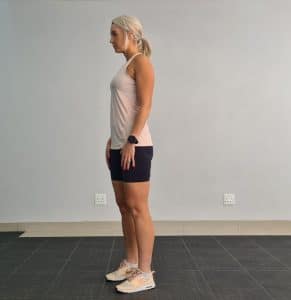 |
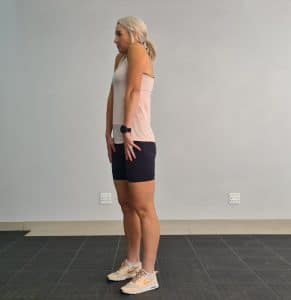 |
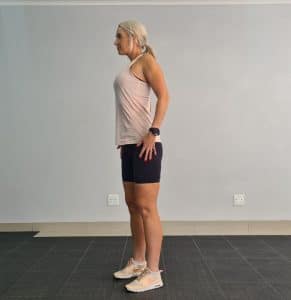 |
Shoulder Rolls
2. Arm Raises
Begin in an upright standing position with your feet shoulder-width apart, maintaining good alignment with your head, shoulders, hips, and legs. Place your arms at your sides. Engage your core and raise both arms overhead, then slowly lower your arms to the starting position and repeat the movement. Complete 10 repetitions.
 |
 |
Arm Raises
3. Standing Twist
Begin in an upright standing position with your feet slightly wider than shoulder-width apart, maintaining good alignment with your head, shoulders, and hips. Arms extended in front of your body with your palms pressed together at chest height. Engage your core and twist your upper body as you open one arm out to the side, keeping your hips locked in the forward position. Return to the starting position and repeat the movement on the opposite side. Complete 10 repetitions.
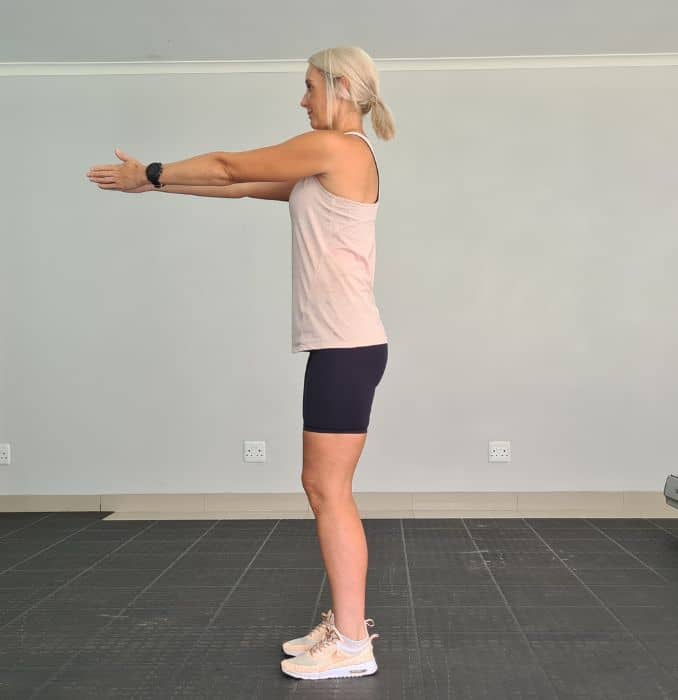 |
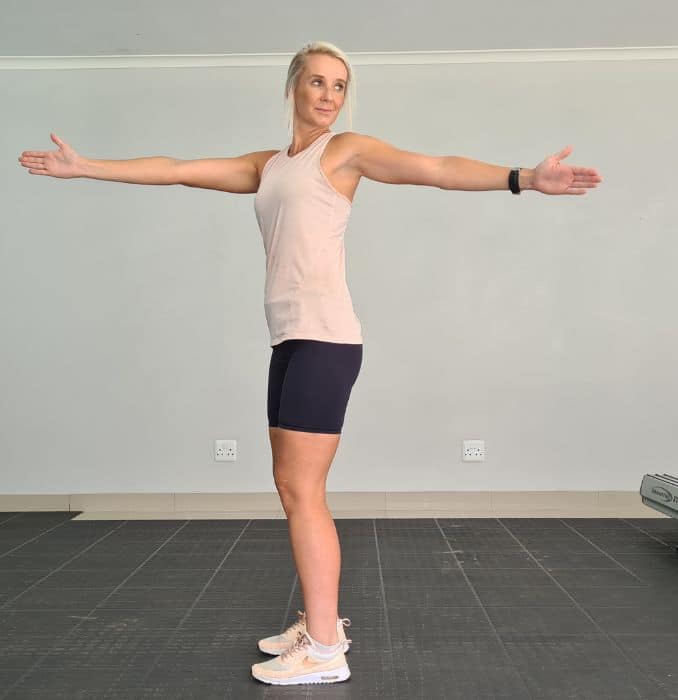 |
Standing Twist
4. Lateral Lunge
Begin in an upright standing position with your feet shoulder-width apart, maintaining good alignment with your head, shoulders, hips, and legs. Place your hands on your thighs. Take one big step to the side with your left foot, then slightly bend your left knee and hinge your hips to lower your seat as you extend your right leg. Repeat the movement on the opposite side. Complete 10 repetitions.
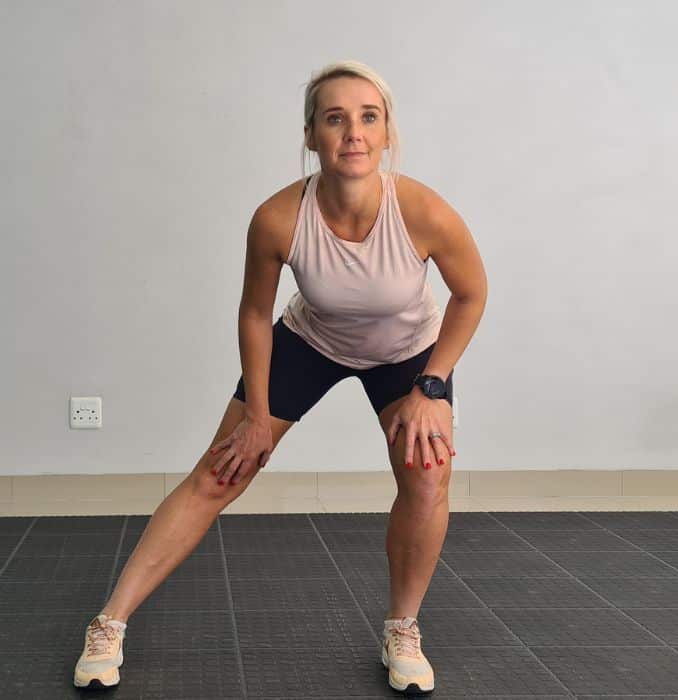 |
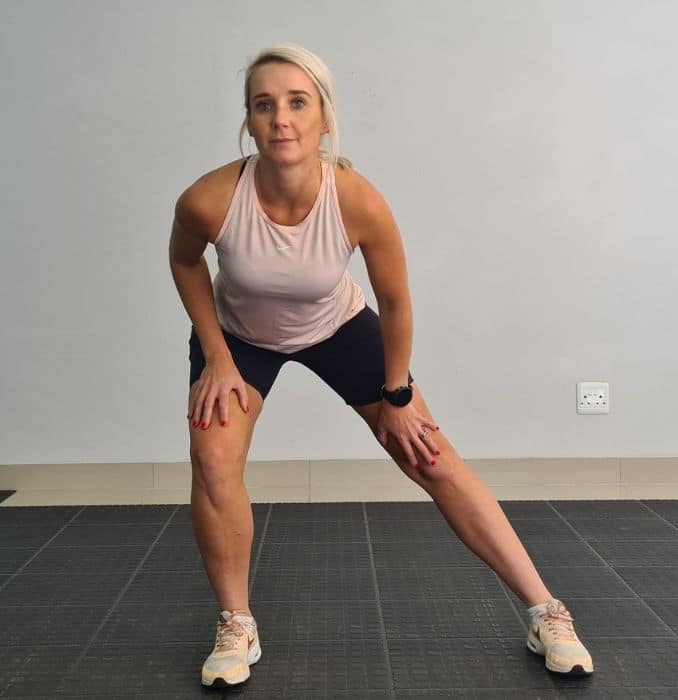 |
Lateral Lunge
Routines
Exercise routines were created to help you reach your fitness goals, and if you follow them diligently, they are a great way to stay fit and healthy. Routines can help you look and feel your best, so make sure to make them part of your healthy lifestyle.
1. Shoulder Sweep
For this exercise, you need a lighter resistance band.
Begin upright with your feet hip-width apart, maintaining good alignment with your head, shoulders, hips, and legs. Step on the center of the band with one foot, holding the ends of the band with both hands with an underhand grip. Engage your core and sweep both your arms straight up to shoulder level, then return to the starting position. Repeat the movement on the opposite side. Complete 10 repetitions.
 |
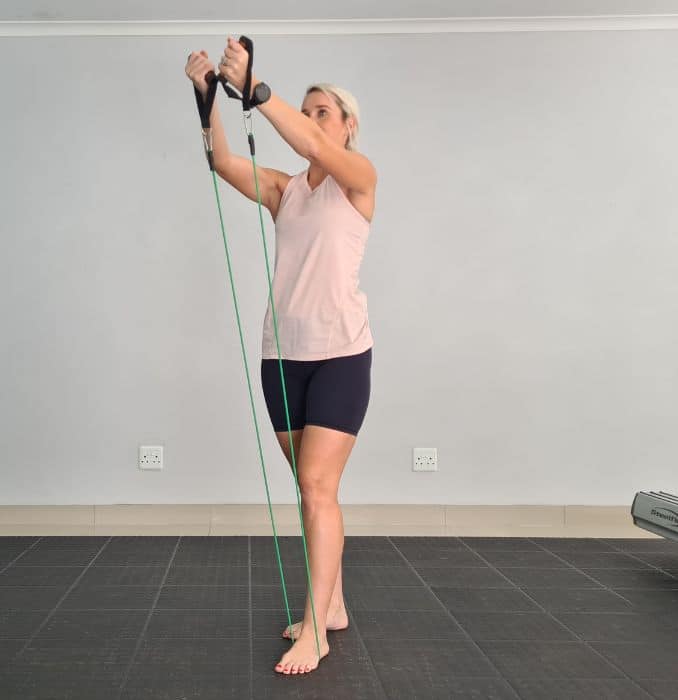 |
Shoulder Sweep
2. Bicep Curls
For this exercise, you need a lighter resistance band.
Begin in an upright standing position with your feet slightly wider than shoulder-width apart, maintaining good alignment with your head, shoulders, and hips. Step on the center of the band with both feet, holding the tubing handle on both ends with an underhand grip. Engage your core and bend both arms to bring the tubing handle to shoulder level, then lower your arms to return to the starting position. Repeat the movements. Complete 10 repetitions.
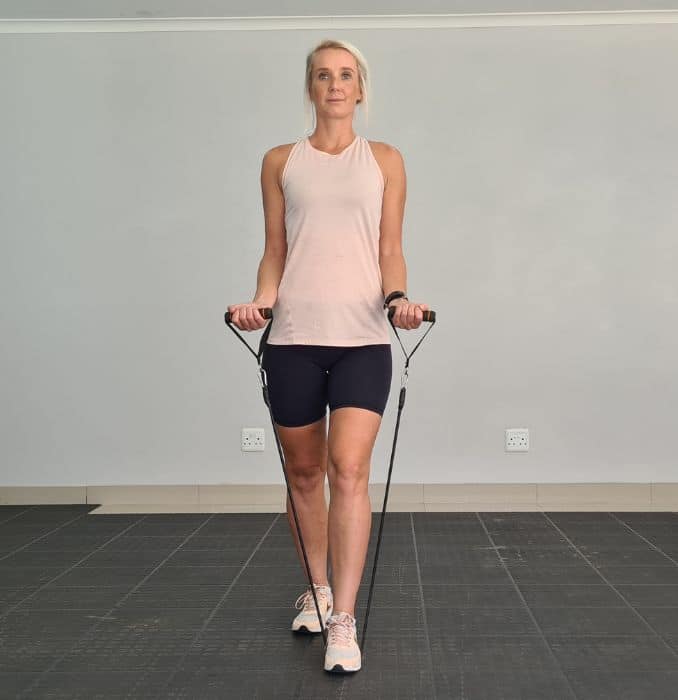 |
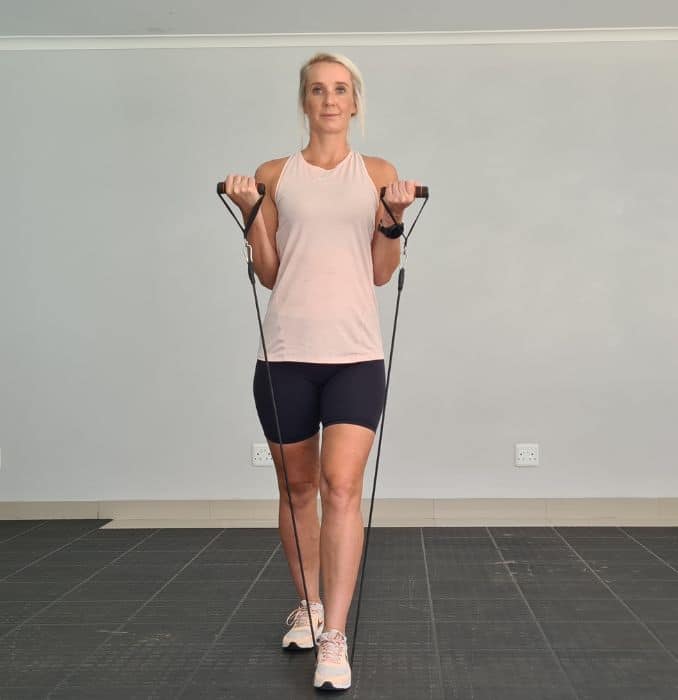 |
Bicep Curls
3. Bend-Over Rows
For this exercise, you need a heavier resistance band.
Begin upright with your feet hip-width apart, maintaining good alignment with your head, shoulders, hips, and legs. Step on the center of the band with your right foot, holding one end of the band with your left hand with an underhand grip. Place your opposite hand on your thigh for support. Engage your core and hinge through your hips to lean your upper body forward. Then, pull your arm back in a rowing motion, keeping your elbow 30 to 45 degrees away from your body, creating resistance on the tubing. Lower your arm down to the starting position and repeat the movement. Complete 10 repetitions on each side.
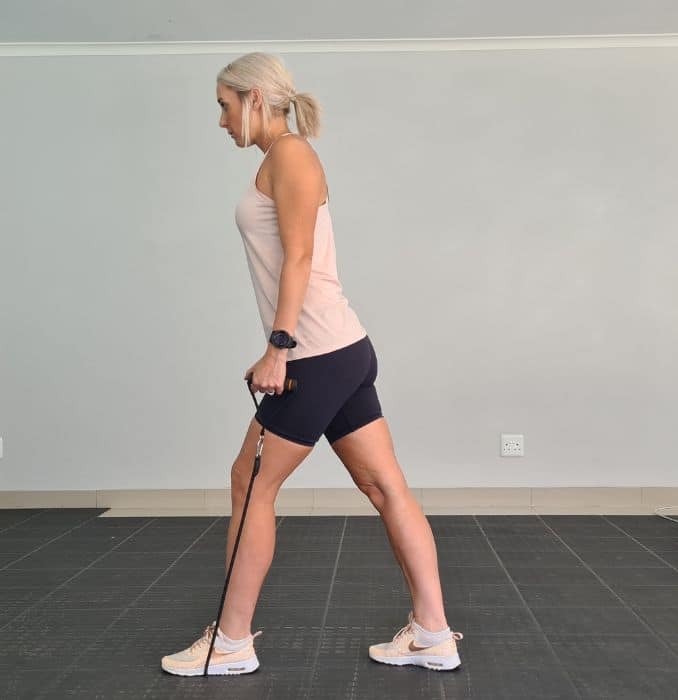 |
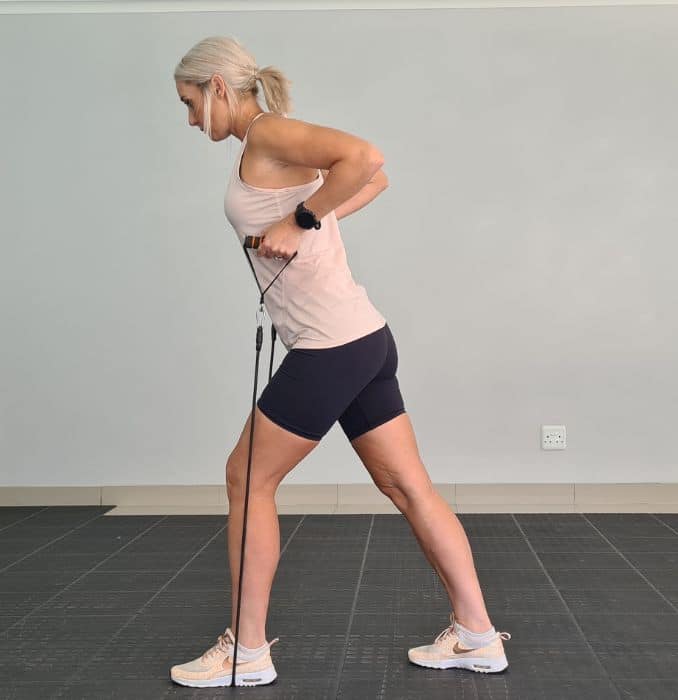 |
Bend Over Rows
4. Lateral Shoulder Raise
For this exercise, you need a heavier resistance band.
Begin upright with your feet hip-width apart, maintaining good alignment with your head, shoulders, hips, and legs. Step on the center of the band with one foot, holding the tubing handle with one hand on the side with an overhand grip. Place your opposite hand on your hip. Engage your core and raise your arm sideways to bring the tubing handle to shoulder height. Lower your arm to return to the starting position and repeat the movement on the opposite side. Complete 10 repetitions on each side.
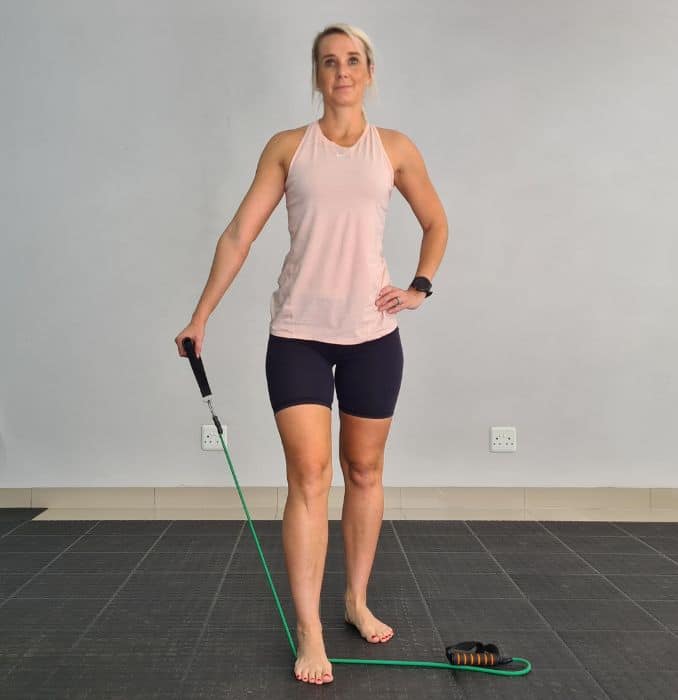 |
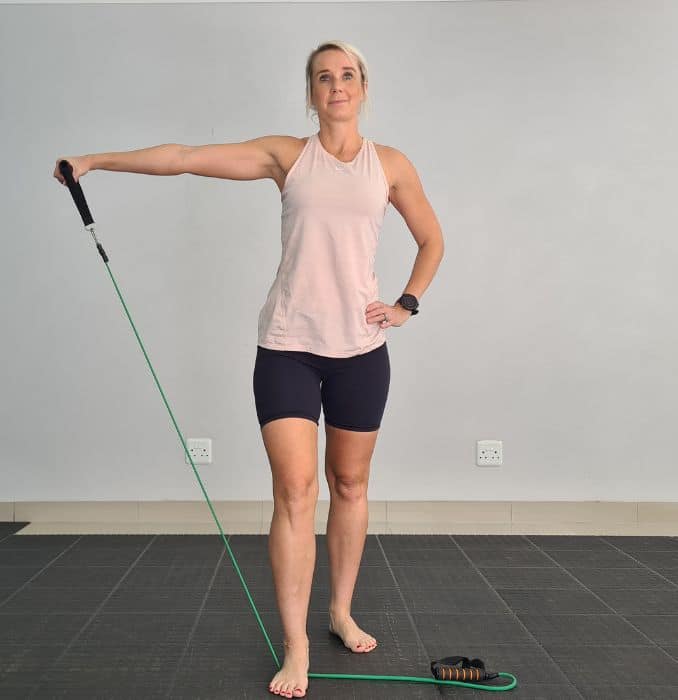 |
Shoulder Flexion
5. Triceps Extensions
For this exercise, you need a heavier resistance band.
Begin in an upright standing position with your feet wider than shoulder-width apart, maintaining good alignment with your head, shoulders, hips, and legs. Hold the ends of the resistance band on each hand. Then, grab the band and allow a little bit of space in the middle. Hinge through your hips to slightly lean your upper body forward. Engage your core and stretch your arms backward, then pull back up at chest height. Repeat the movements. Complete 10 repetitions.
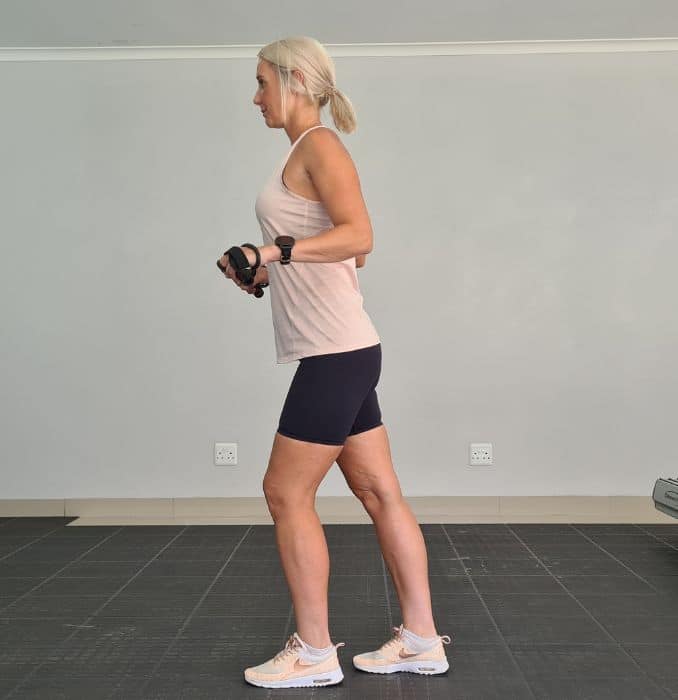 |
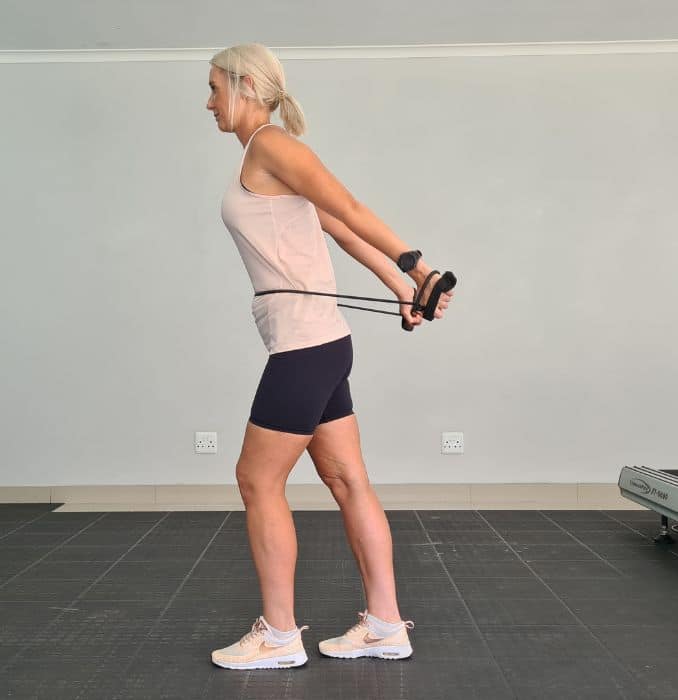 |
Triceps Extensions
6. Shoulder External Rotation
For this exercise, you need a heavier resistance band.
Begin upright with your feet hip-width apart, maintaining good alignment with your head, shoulders, hips, and legs. Hold the ends of the resistance band on each hand, then fold the band, allowing a little bit of space on the side to stretch, and hold it in front of your body. Engage your core, then pull one arm on the side, creating resistance on the tubing. Return to the starting position and repeat the movement. Complete 10 repetitions on each side.
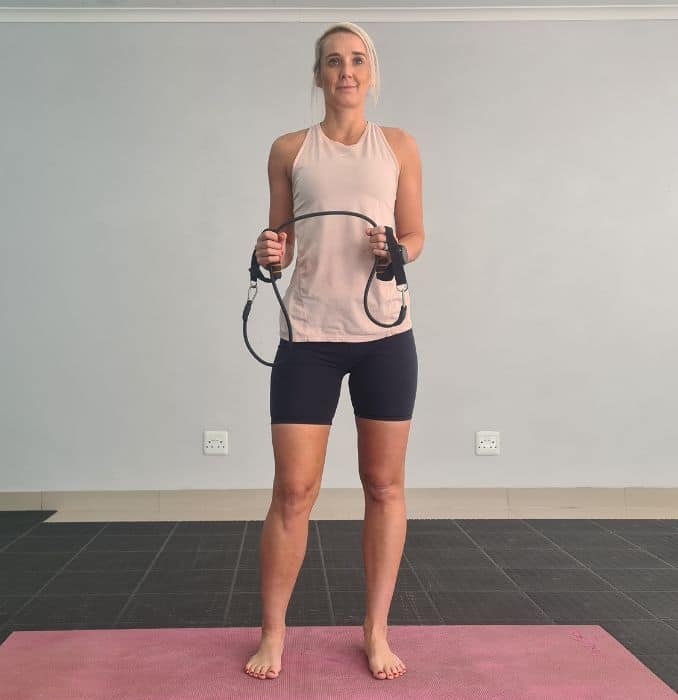 |
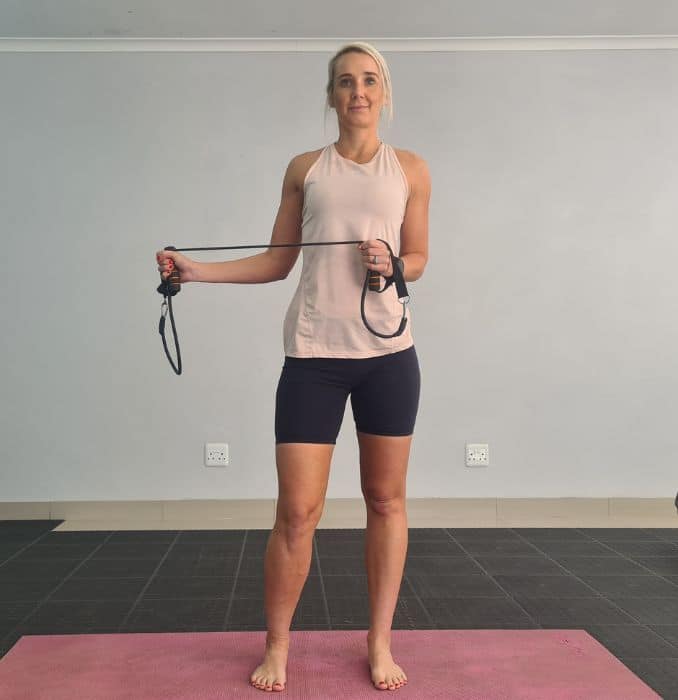 |
Shoulder External Rotation
Cool Downs
Cool-down exercises are an important part of any exercise routine. Cooling down after a workout helps to reduce the amount of lactic acid buildup in the muscles, which can cause soreness and stiffness. Cooling down also helps gradually reduce your heart and breathing rate, allowing your body to return to its pre-exercise state faster.
1. Side Stretch
Begin in an upright standing position with your feet slightly wider than shoulder-width apart, maintaining good alignment with your head, shoulders, and hips. Interlace your fingers together and flip them with palms facing outwards. Then raise your arms overhead. Engage your core and slightly bend your upper body to the side. Repeat the movement on the opposite side. Hold each position for several deep belly breaths, in through your nose and out through your mouth.
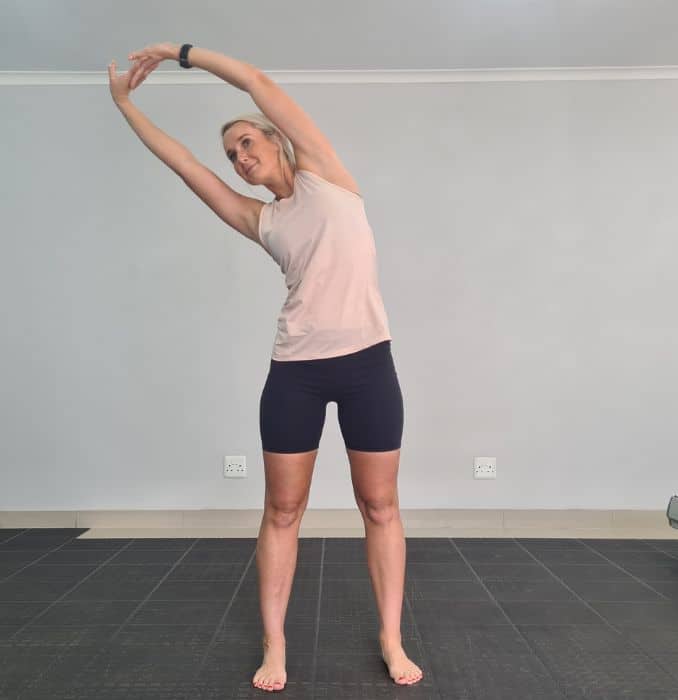 |
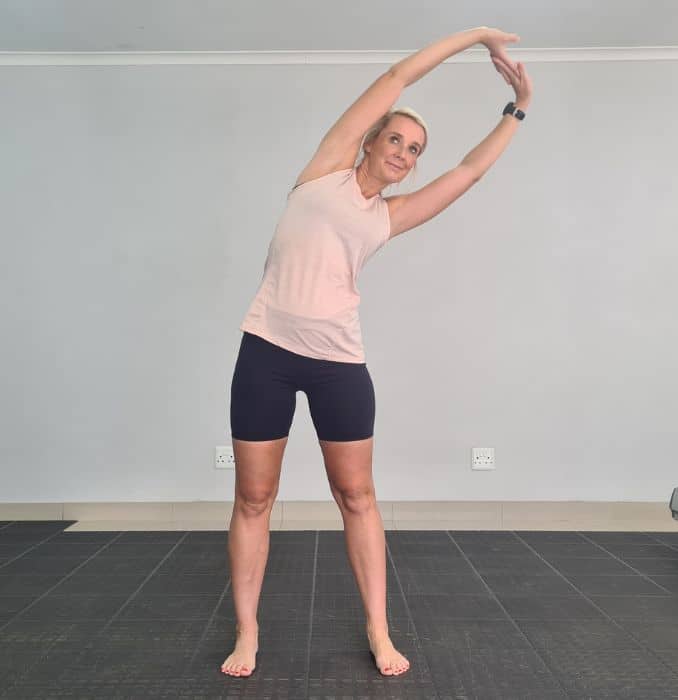 |
Side Stretch
2. Standing Cat-Cow
Begin upright with your feet hip-width apart, maintaining good alignment with your head, shoulders, hips, and legs. Engage your core and hinge through your hips to move your upper body forward. Place your hands on your knees. Slowly round your mid-back as you bow your head down. Alternate by lifting your head and placing your hands at the back of your hips then arching your mid-back. Hold each position for several deep belly breaths, in through your nose and out through your mouth.
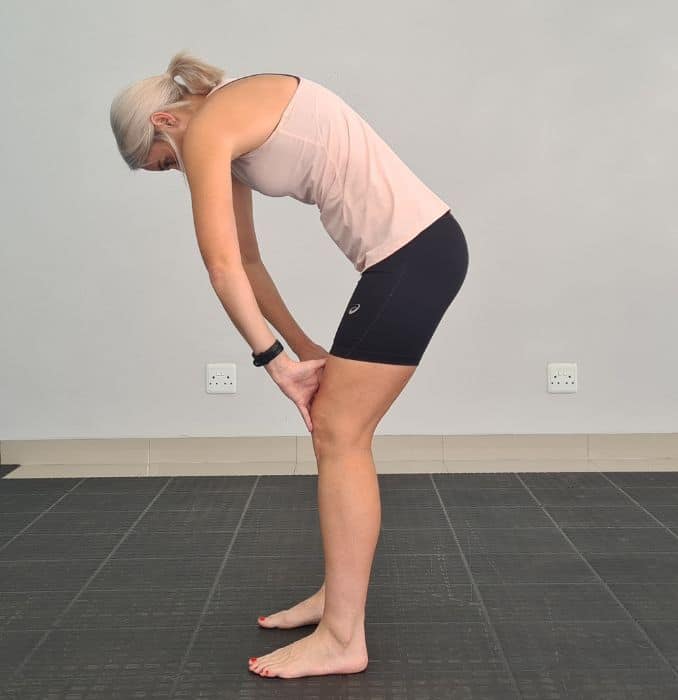 |
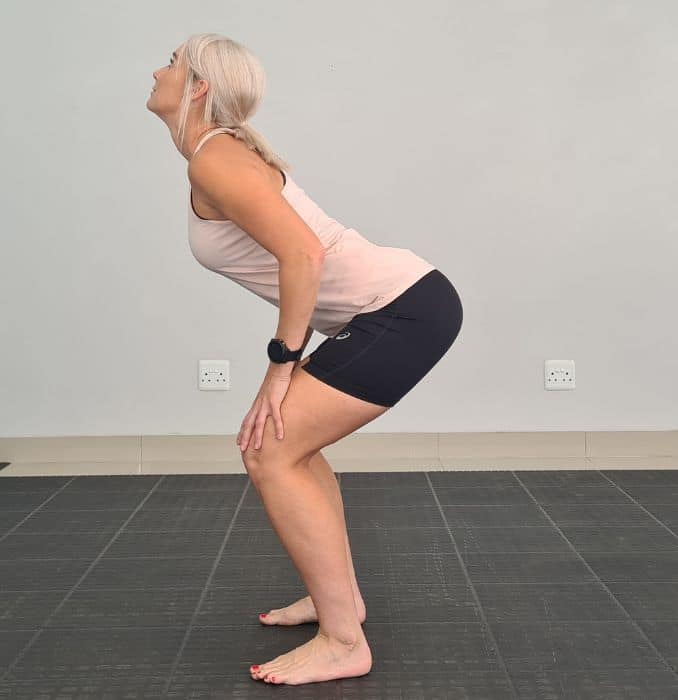 |
Standing Cat-Cow
3. Cross Arm Stretch
Begin in an upright standing position with your feet slightly wider than shoulder-width apart, maintaining good alignment with your head, shoulder, and hips. Engage your core and position one arm across your body at shoulder height, then intensify the stretch by pulling your arm closer to your chest using your opposite hand. Hold the position for a couple of seconds. Repeat the movement on the opposite side.
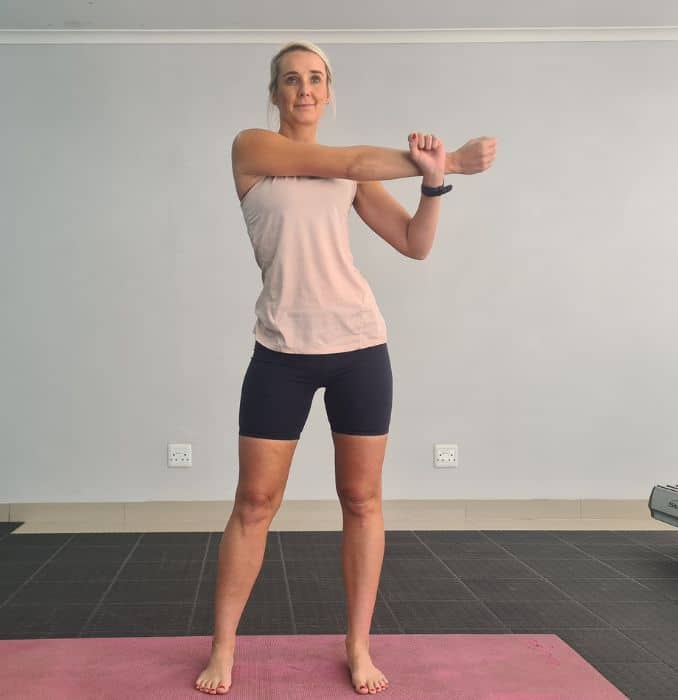
Cross Arm Stretch
4. Chest Stretch
Begin in an upright standing position with your feet slightly wider than shoulder-width apart, maintaining good alignment with your head, shoulder, and hips. Engage your core and place your hands at your back as you open your chest out, looking for a light stretch, then bend your head to the side. Hold the position for several deep belly breaths, in through your nose and out through your mouth.
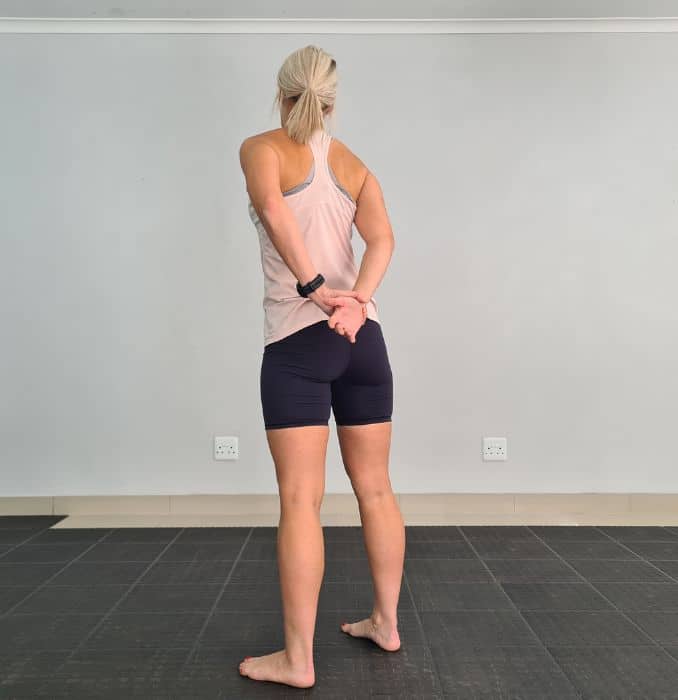
Chest Stretch
5. Triceps Stretch
Begin your upper body workout in an upright standing position with your feet shoulder-width apart, maintaining good alignment with your head, shoulders, hips, and legs. Engage your core and raise your left arm up towards the ceiling while bending the elbow, placing your hand at the back of your shoulder. Hold onto the elbow with your right hand to slowly push your elbow further back to intensify the stretch. Hold this position for a couple of seconds. Relax and slowly return back to the starting position and repeat the movement on the opposite side.
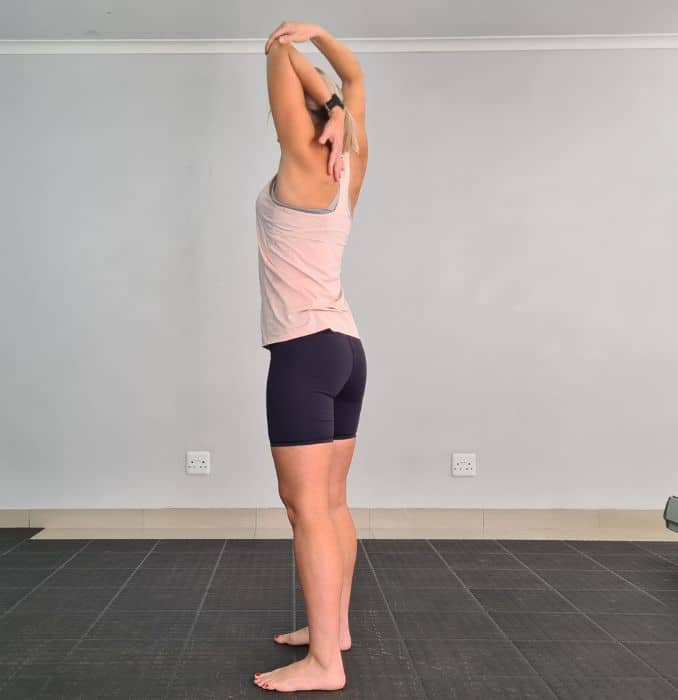
Triceps Stretch
Upper Body Muscles Targeted by Resistance Band Training
Resistance band training can be used to target a wide range of upper body muscles, including:
1. Biceps
The biceps are located on the front of the upper arm and are responsible for flexing the elbow joint. Resisted curls are a great exercise for targeting the biceps.
2. Triceps
The triceps are located on the back of the upper arm and are responsible for extending the elbow joint. Resisted triceps extensions are a great exercise for targeting the triceps.
3. Forearms
The forearm muscles are located on the underside of the forearm and are responsible for wrist and finger movements. Resisted wrist curls and reverse wrist curls are great exercises for targeting the forearm muscles.
4. Pectorals
The pectoral muscles are located on the chest and are responsible for movements such as pushing and hugging. Resisted chest presses and flies are great exercises for targeting the pectoral muscles.
5. Deltoids
The deltoids are located on the shoulders and are responsible for shoulder movements such as the shoulder press and raising and rotating the arm. Resisted shoulder presses and lateral raises are great for targeting the deltoids.
6. Rotator Cuffs
The rotator cuffs are a group of muscles and tendons that surround the shoulder joint and are responsible for stabilizing the joint during movements. External and internal rotations with resistance bands are great exercises for targeting the rotator cuffs.
7. Trapezius
The trapezius muscles are located in the upper back and are responsible for movements such as shrugging and pulling the shoulders back. Resistance band rows and shoulder blade squeezes are great exercises for targeting the trapezius muscles.
Conclusion
Upper body strength training is an important part of a holistic fitness routine. It can help build muscle, improve posture, and reduce the risk of injury. Many different exercises can be used to train the upper body, and most exercises can be modified to make them more or less challenging. One of the best ways to build upper body strength is to use body resistance band upper body workouts. Body resistance bands are inexpensive and portable, and they can be used to target all of the major muscle groups in the upper body.
A NASM-certified personal trainer can help you to create an upper-body strength training program that is safe and effective for your individual needs. They can also teach you proper form and technique, which is important to prevent injury.
If you are new to upper body strength training, it is important to start slow and gradually increase the intensity of your workouts over time. It is also important to listen to your body and take breaks when needed.
With regular exercise, you can build strong, healthy upper body muscles that will help you perform everyday activities with ease. So what are you waiting for? Get started on your upper body strength training today!

